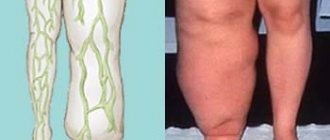Polyps in the rectum, the symptoms of which almost do not appear in the very first stages, are considered a very dangerous disease. Growing inside the intestines, they practically do not bother a person and can be discovered randomly during a routine examination by a doctor or during the diagnosis of another disease.
Externally, they appear as round, mushroom-shaped, grape-shaped or even branched formations of various colors. Often their color matches the color of the rectal mucosa, however, depending on the number of blood vessels feeding them and the presence/absence of inflammation in the tissues, the neoplasms can become bright red, crimson or purple.
Polyps are usually attached to the lining of the rectum with the help of a wide stalk, but there are cases when there are many of them and they spread along the wall in rows. Their surface can be smooth or bumpy.
It is statistically confirmed that at the age of 30-40, polyps in the rectum can be noticed in 5-10% of people, but with age (60 years and older) they are diagnosed in half of the patients. In children and adolescents, such a disease can be found extremely rarely.
Etiology
Rectal polyps are neoplasms that are diagnosed in absolutely any person, regardless of their gender and age category.
Such a tumor formation is attached to the walls of the rectum with the help of a pedicle. It is noteworthy that polyps can appear in any organ of a hollow structure, but among the gastrointestinal tract organs they are most common.
Despite the fact that the reasons for the appearance of polyps are unknown, clinicians have identified several theories of their formation. The most common assumption considers such benign tumors as a consequence of a chronic inflammatory process in the walls of the rectum.
Since the disease can be diagnosed in a child, there is also a theory that this is facilitated by improper formation of the intestinal walls and mucous layer of the digestive tract during the period of intrauterine development of the fetus.
In addition, there are other predisposing factors for the appearance of polyps in the rectum and their growth. These include:
- unfavorable environmental conditions;
- lack of physical activity in a person’s life;
- poor nutrition, in particular the consumption of large quantities of foods and dishes that irritate the walls of the gastrointestinal tract. This should include irregular meals, addiction to fatty and spicy foods, smoked and canned foods, pickles and confectionery, coffee and carbonated drinks;
- abuse of bad habits, in particular drinking alcohol;
- the course of severe infectious diseases;
- failure of the human immune system;
- regular exposure to stress;
- hormonal imbalance, which can occur due to dysfunction of the ovaries or adrenal glands;
- uncontrolled use of medications.
Also, the possibility of a genetic predisposition cannot be ruled out, because very often rectal polyps formed in people whose relatives had a similar problem. Moreover, it is believed that familial polyposis is most often prone to transformation into cancer.
What are polyps
As mentioned above, neoplasms form on the intestinal wall and often disrupt the functioning of the gastrointestinal tract. Intestinal polyps take many forms: they often look like mushrooms or a bunch of grapes. However, neoplasms can be flat or round.
In addition to their shape, colonic neoplasms vary in size and number—they occur alone or in groups throughout the colon and rectum.
Most often, intestinal neoplasms are adenomas (benign formations). However, as the tissue grows, it can degenerate into a malignant polyp of the rectum. The larger they become, the higher the risk of cell degeneration.
Cancer
About ten percent of the population suffers from intestinal polyps. Genetic factors play a role in the development of the disease: a family predisposition to the formation of these neoplasms has been proven. With hereditary diseases, the risk of cancer is much higher than the average in the population.
With age, the likelihood of developing polyps increases greatly. Every third person over 55 years old has polyps in the intestines. The Western lifestyle and diet high in sugars, fats, low in fiber, alcohol and nicotine abuse become leading factors in the formation of various types of polyps. Research has shown that more people suffer from this problem in Western Europe and North America than in other parts of the world.
Classification
Depending on the number and extent of the pathological process, polyps in children and adults are:
- single;
- multiple - in this case, several neoplasms are observed in different zones of this organ;
- diffuse - in which polyps cover the entire surface of the affected organ. In such cases they talk about polyposis. Diffuse polyposis of familial origin is most often diagnosed.
According to their morphological structure, benign formations are divided into:
- glandular polyp - consists of the upper layer or glandular tissue of the lining of the rectum;
- glandular villous polyp;
- a villous polyp of the rectum is a node that is covered with a large number of blood vessels and is very vulnerable to mechanical damage;
- cystic granular polyp;
- hyperplastic type;
- fibrous polyp - includes connective tissue cells and often develops from a hemorrhoidal lump. It is because of this factor that pathology is treated by specialists from the fields of proctology and gastroenterology;
- adenomatous polyp - differs from other forms in that it most often transforms into cancer. This process is observed in 1% of all cases.
A separate type is pseudopolyposis - which is the growth of the lining of the rectum like polyps. This occurs against the background of inflammation in the gastrointestinal tract.
Despite the presence of several forms of the disease, the symptoms and treatment for them will be exactly the same.
Why are polyps in the intestines dangerous?
Most diagnosed polyps are adenomatous. They have a high probability of degeneration into cancer - up to 75%. To determine the structure and degree of danger of the growth, it is examined under a microscope. Tubular polyps are considered the safest. The most unfavorable prognosis is for villous formations. They malignize into malignant tumors more often than others.
Any polyp detected has a tendency to grow. With the size of the formation, the risk of degeneration also increases. Therefore, even the smallest growths must be removed. Hyperplastic, hamartomatous and inflammatory polyps are not prone to malignancy.
Intestinal polyposis is dangerous due to the possibility of developing severe complications:
- prolonged intestinal bleeding;
- chronic constipation;
- intestinal obstruction;
- pronounced flatulence;
- deterioration of general condition due to anemia;
- disorders of intestinal function, manifested by diarrhea, constipation;
- volvulus;
- ulcerative lesions of the intestinal mucosa;
- perforation of the intestinal wall.
The only way to avoid serious consequences is preventive examinations of the intestines for the purpose of early detection of polyposis.
Symptoms
Symptoms of polyps in the rectum are not specific, which means that their presence cannot accurately indicate the course of this particular disease. Moreover, for quite a long time, clinical manifestations may be completely absent. The first signs will appear when several polyps form or when the tumor reaches a large size.
Often, pathology is a diagnostic surprise and is discovered during a preventive examination or when diagnosing a completely different ailment.
The most common signs of polyps in the rectum:
- pain – they are localized in the lower abdomen or in the iliac region, and are also aching in nature;
- violation of the act of defecation, which is expressed in constipation and diarrhea, but most often patients complain of constipation, since the tumor leads to partial intestinal obstruction;
- formation of anal fissures and hemorrhoids, often internal;
- rectal bleeding is the most specific symptom, since its occurrence forces people to seek qualified help;
- itching and burning in the anal area;
- discomfort during bowel movements;
- the appearance of pathological impurities in the stool - we are talking about blood and mucus;
- an increase in temperature indicates the addition of an infection;
- sensation of a foreign object in the anal passage - this symptom is not permanent, but is paroxysmal in nature;
- redness and swelling of the skin around the anus - this occurs against the background of constant secretion of mucus or blood from the anus.
Polyps in the rectum in children can only be diagnosed through instrumental research methods, since a sign such as anal hemorrhage is characteristic of a large number of pathologies. It is because of this that if one or more of the above symptoms occur, you should consult a doctor as soon as possible.
Symptoms of polyps in the intestines
The clinical picture of the pathology depends on the degree of proliferation of polypous formations. At the beginning, the patient does not feel any changes in health and does not make any complaints. Due to the asymptomatic course of polyposis, early diagnosis is difficult.
The first symptoms of the disease:
- pain in the abdomen;
- discharge of mucus from the rectum;
- discomfort during bowel movements.
These symptoms are often not taken seriously by patients. They are soon joined by more severe manifestations:
- blood in the stool;
- secretion of a large amount of mucus, both during bowel movements and without it;
- frequent urge to go to the toilet;
- burning sensations in the rectum, itching in the anus;
- alternating constipation with diarrhea.
Colon polyps
The admixture of blood in the form of dark stripes in the feces indicates damage to the large intestine. The brighter the blood, the lower the polypous formation is localized in the intestine. Mushroom-shaped, thick or thin polyps can reach impressive sizes - up to 6 cm, causing pain in the colon.
Rectal polyps
Rectal polyps can develop asymptomatically for many years. Obvious symptoms appear when the inflammatory process develops or the integrity of the formations is violated. Patients complain of heavy anal bleeding and intense mucus secretion.
Polyps of the sigmoid colon
With the development of sigmoid colon polyposis, alternation of painful constipation and diarrhea is noted. Flatulence and belching may develop. When visiting the toilet, blood, pus, and mucus are released with stool.
Small intestinal polyps
Polyps rarely grow in the small intestine, but they can cause profuse bleeding, volvulus, and obstruction. Quite often, during examination it is possible to establish the penetration of the affected part of the intestine into another. Polyps of the small intestine are most prone to malignancy. Symptoms of small intestinal polyposis:
- flatulence;
- nausea;
- heartburn, belching;
- pain in the upper abdominal cavity;
- feeling of a full stomach;
- cramping abdominal pain;
- indomitable vomiting is a sign of polyposis of the upper parts of the small intestine.
Duodenal polyps
Polyps of the duodenum occur for a long time without severe symptoms. When tumors increase in size, specific signs of the disease appear:
- soreness in the navel area;
- constant nausea;
- belching with a rotten taste;
- feeling of a full stomach.
In severe cases of duodenal polyposis, specific symptoms of intestinal obstruction are determined:
- cramping abdominal pain;
- vomiting of poorly digested food;
- During auscultation, a splashing sound is heard in the abdomen.
In some cases, a polyp can be seen in the feces, detached from the intestinal wall. Polyps are nourished by the absorption of nutrients from the bloodstream. The patient develops signs of general exhaustion, pallor, dark circles under the eyes. In later stages of the disease, all symptoms worsen.
Diagnostics
Establishing a correct diagnosis is based on instrumental examinations, but they must be supplemented by laboratory tests and preceded by a physical examination.
Thus, if a polyp occurs in the rectum, the primary diagnosis will include:
- studying the life history and medical history of not only the patient, but also his close relatives - this is necessary to confirm or refute heredity or identify another most characteristic predisposing factor;
- the clinician conducting a thorough physical examination of the anorectal area to assess the condition of the skin and the possible detection of a large prolapsed polyp. This also includes digital examination of the anal canal;
- a detailed survey of the patient - to determine the first time of appearance and severity of symptoms of a polyp in the rectum, as well as the presence of additional symptoms.
Symptoms
As Professor Sklifosovsky used to say: the main symptom of polyposis is the absence of symptoms!
The difficulty of diagnosis at an early stage lies in the absence of specific clinical symptoms for rectal polyp (polyposis). That is, signs characteristic of polyposis can occur with hemorrhoids, and with a tumor, and with a fissure of the rectum. Only a specialist (proctologist) can carry out differential diagnosis using a routine examination and endoscopic examination methods.
R.polyp begins to “announce its existence” when it reaches a certain size, or when an infection attaches to it. In such cases, the patient may notice symptoms such as
- then diarrhea, then constipation,
- pain in the abdomen,
- discharge of mucus and (or) blood during bowel movements,
- the release of copious mucus and diarrhea with mucus is a symptom characteristic of adenomatous polyps, the same ones that more often degenerate into cancer.
- a feeling of fullness or a feeling of a foreign body in the rectum.
- if the polyp is on a long stalk, it can cause intestinal obstruction, blocking the lumen of the intestinal tube.
- the polyp can also fall out (prolapse) from the anus and become pinched.
If the first signs appear indicating the possibility of a disease of the rectum, then when visiting a proctologist, sometimes a digital examination will be enough to understand whether it is hemorrhoids, a polyp or an anal fissure.
It is possible to protect yourself from this disease only by undergoing regular preventive examinations. In the absence of polyps, the frequency of examination by a proctologist is advisable once every 5 years, especially after the age of 50 years.
If there are predisposing factors, it is advisable to undergo medical examinations once a year. In a family with hereditary polyposis, children should be examined by a geneticist, and they undergo a colonoscopy every year from 10-12 years to 40 years, even if polyps are not detected.
Treatment
Confirming the diagnosis of polyps in the rectum requires immediate hospitalization of the patient and surgery. Excision of a benign neoplasm is performed in several ways:
- endoscopic procedures – this includes electroexcision. This method of therapy is used for both large and small polyps. The difference is only in the number of such minimally invasive operations;
- surgically - often used for familial diffuse polyposis or suspected malignancy. In such cases, treatment of rectal polyps is performed transanally or through an open approach. The issue of complete or partial resection of the rectum is resolved individually with each patient.
It is worth noting that treatment without surgery is impossible.
In the postoperative period, patients also need to follow some rules that will prevent the development of complications or relapse of the disease. Postoperative treatment is prescribed only by a doctor and consists of:
- taking medications to relieve symptoms;
- maintaining a gentle diet;
- the use of topical medications - most often prescribed suppositories for polyps with an anti-inflammatory effect;
- use of alternative medicine.
The latter treatment option should not be the only way to recover. Nevertheless, treatment with folk remedies involves the use of the following medicinal herbs and plants:
- hog uterus;
- spruce or pine needles;
- celandine and St. John's wort;
- yarrow and chaga;
- honey and horseradish;
- oak bark and viburnum.
Rectal Polyp
Let's figure out in order what it is - a rectal or rectal polyp, and when symptoms appear.
The medical literature says that this is a protrusion of the mucous membrane into a hollow organ (in this case, the rectum).
A rectal polyp is a formation of soft consistency that grows from the mucous membrane. When there are several of them, they already talk about rectal polyposis. Their shapes can be different: spherical, pear-shaped, branched, grape-shaped, oval.
These outgrowths sometimes have a stalk or “sit” on a broad base. Their sizes range from 0.5 cm to 3 cm. Large rectal polyps (2-3 cm) cause particular inconvenience to the patient, as they can block the intestinal lumen, causing constipation and strangulation. That’s when scant symptoms appear, allowing one to suspect a rectal disease.
Complications
Despite the fact that rectal polyps are benign formations, ignoring symptoms or starting therapy late can cause the development of the following complications:
- anemia – appears against the background of profuse rectal hemorrhages;
- involvement of other parts of the rectum in the pathological process;
- anal fissure;
- transformation into oncology.
It is precisely because of the possible formation of such consequences that patients should not have a question: should rectal polyps be removed?
What is a villous polyp?
The tumor got its name because of its appearance. Under a microscope, the surface of the neoplasm consists of multiple tiny hairs and has an irregularly shaped stroma. The smallest blood and lymphatic vessels pass inside the fibers. The abundance of the vascular component leads to rapid tumor growth and proliferation of pathological cells.
Histologically, there are several types of villous polyps:
- Proliferating. The stroma is formed by epithelium with signs of proliferation. This process stimulates cells to intensively divide, so they are crowded, without a contour and literally layered on top of each other.
- Hyperplasiogenic. They are formed in foci of mucosal hyperplasia and subsequently develop into adenomatous tumors. Information about the symptoms and treatment of adenomatous rectal polyp in this article.
- Malignant. Full-fledged tumors with cancer cells.
Neoplasms grow inside the intestinal lumen, but as they develop, the tumor can go deeper into the epithelial layers.
Almost every fifth villous polyp transforms into a cancerous tumor.
Prevention and prognosis
Specially designed preventive measures to prevent the development of such a disease have not been developed. However, the following general rules are recommended:
- lead a healthy and moderately active lifestyle;
- eat properly and rationally;
- take medications strictly as prescribed by the doctor;
- promptly treat any inflammatory or infectious processes of the gastrointestinal tract;
- avoid stress if possible;
- undergo a complete preventive medical examination several times a year.
Timely diagnosis and treatment of such a disease increases the chances of a favorable outcome and reduces the likelihood of complications. However, the possibility of relapse of the disease cannot be ruled out; this often occurs several years after the operation. Familial polyposis has an unfavorable prognosis - it can develop into cancer.
Rectal polyps are one of the most common benign epithelial tumors of the intestine. This is an asymptomatic disease that can cause quite a lot of trouble to the human body if it is not diagnosed and treated in time.
A rectal polyp is formed during the growth of the glandular epithelium of the intestinal wall into its lumen. A pear-shaped or rounded formation, as a rule, has a thin stalk or a wide base. They can be single or multiple.
Classification of polyps
During the research process, an extensive classification of rectal polyps was created. First of all, it is worth noting that all benign tumors of the rectum are divided into two main types: epithelial, which are the most dangerous and common, and rare neoplasms, the prevalence of which does not exceed 3.5%.
Rectal polyps are divided according to the following criteria: multiplicity, size, geological structure. Multiplicity criteria distinguish such groups of polyps as single, diffuse multiple (group and scattered). Based on their histological structure, it is possible to distinguish such types of polyps as glandular, hyperplastic, villous and glandular-villous. As for the size of polyps, their malignancy directly depends on it.
Glandular polyps are most prone to malignant degeneration. That is why, if a patient is found to have this type of polyp, he is diagnosed with a precancerous condition. Quite often, villous polyps that have a round or elongated shape and a velvety pink-red surface develop into cancer. It is worth noting that most polyps go through several successive stages of development: small neoplasms increase in size over time, after which they can even degenerate into malignant tumors.
One of the most dangerous types of polyposis is diffuse, which is also called familial. It is characterized by the growth of a large number of polyps in the rectum and other organs. Statistical data from scientists confirm that the risk of malignant degeneration of diffuse polyps reaches 80-100%. That is why it is extremely important to diagnose this type of polyps as early as possible in order to prevent their growth and transformation into malignant cancer.
Causes
Various factors can provoke the development of polyps in the rectum. There are many reasons for their formation. Among them:
- heredity, which explains the disease in children;
- haemorrhoids;
- intestinal infection (for example, dysentery);
- inflammation in the intestines (especially ulcerative colitis);
- anal fissures;
- diverticular disease;
- passive lifestyle;
- age;
- poor environmental situation;
- alcoholism;
- dyskinesia in the intestines;
- chronic constipation;
- digestive disorders;
- smoking;
- vascular pathologies;
- violation of the diet and balance of proteins, fats and carbohydrates, the predominance of animal foods in the diet.
The exact causes of rectal polyps could not be established.
Symptoms characterizing rectal polyps
With rectal polyposis, people experience a number of symptoms typical for this disease. The main one is irregular bowel movements - alternating diarrhea and constipation. This symptom appears at the very first stages of the disease. This is due to primary irritation of the intestinal walls by the tissues of the developing polyp.
Subsequently, due to the steadily narrowing lumen of the intestine, the clinical picture begins to change. The patient is increasingly worried about long-term constipation, and their duration directly depends on how narrow the lumen has become. Such complaints often become the reason for going to the doctor.
Another symptom indicating the presence of neoplasms is severe discomfort in the rectal area and the feeling that there is something foreign in it. This sign makes itself felt when the formation grows to a large size.
A person feels small growths relatively rarely, and then only during contractions of the intestinal walls (during defecation). In this case, discomfort appears either from the pubic region or in the rectum itself.
Development and forms of formations
With polyposis, which has not been treated for a long time, the patient constantly experiences a feeling of fullness in the intestine. This feeling is only intensified by chronic constipation.
Pain in the lower abdomen is another characteristic sign of the presence of polyps in the rectum. It appears due to stagnation of digested food in the depths of the large intestine. As mentioned above, an overgrown tumor almost completely closes the lumen of the rectum and thereby provokes defecation disorders and the formation of chronic constipation. Due to excessive accumulation of waste food, the walls of the colon are stretched. As a result, this content puts pressure on nerve cells, which are found in abundance in the intestinal mucosa, and causes nagging pain. The situation becomes more serious if there is an accumulation of gases.
When mucous cells - obligatory companions of polyps - work more actively, the presence of a large amount of mucus in a person’s feces becomes noticeable. Normally, it is necessary to moisturize the organ cavity and facilitate the separation of feces. And in the case of a constantly growing tumor, the glands have to work in a tighter mode.
Excess mucus is not completely removed from the body. Most of it accumulates in the anal sinuses and serves as an excellent breeding ground for pathogens. Mucopurulent discharge will indicate an advanced disease process and infection.
The most obvious symptom indicating the neglect of the disease process is the presence of blood in the stool or bleeding from the sphincter. The cause of this alarming sign may be pinching of the tumor, damage to the vessels located in the submucosal layer of the intestine, or tissue necrosis.
Types of polyps
According to the classification, polyps can be:
- Adenomatous - appearing in the rectum against the background of a failure in the processes of normal renewal of the epithelium under the influence of various kinds of reasons. Uncontrolled division of epithelial cells occurs, growth of neoplasms in colonies with gradual blocking of the intestinal passage and injury to the walls after each passage of feces. The adenomatous polyp quickly increases in size, causing the patient discomfort and itching in the anal area. The main danger is malignancy, degeneration into a tumor or cancer, as well as acute intestinal obstruction, which requires urgent elimination, surgery with a further long period of rehabilitation.
- Villous polyps of round shape, pink-red color in the form of villi with a velvety surface when growing from glandular tissues containing papillae similar to villi. They are prone to malignancy and the development of a secondary branching tumor of connective tissue covered with a layer of columnar epithelium with many goblet cells. First, the villous polyp grows from the mucous membrane of the epithelium, as it increases in size, it blocks the intestinal lumen, when it reaches 10–15 cm, it leads to the discharge of a viscous secretion from the mucosa, similar to chicken protein, against the background of the production of mucus in large quantities, thereby provoking frequent loose stools with mucus and blood. The patient experiences a constant feeling of pressure on the rectum, frequent constipation, intestinal obstruction, and blockage of the lumen. A villous polyp can only be recognized by digital examination. As a rule, this is a new formation of jelly-like consistency from loose tissue.
- Fibrous - with growth from connective epithelial tissue and its replacement with fibrous and pathological. Polyps are prone to becoming malignant and developing an inflammatory process. As a rule, this is a false polyp, covered on top with a layer of ordinary epithelium, but with a tendency to degenerate into a malignant tumor, hypertrophy of the anal papillae, and the formation of fibrous polyps in the form of a pear-shaped growth.
This classification of polyps is conditional. Almost every type of polyp is prone to malignancy and the ability, after a certain time, to lead to rectal cancer.
Types of intestinal polyps
Based on their structure, there are several types of intestinal polyps:
- Hyperplastic. The typical place of development is the rectum. They differ in small sizes. They are of benign origin and are not prone to degeneration into cancer.
- Hamartomatous. They are formed from normal tissues due to a non-standard combination of tissue components. Most often diagnosed in adolescence, they are localized in the colon.
- Adenomatous. Precancerous formations. The possibility of degeneration is influenced by the size of the tumor - the larger it is, the higher the likelihood of developing a tumor. Polyps larger than 2 cm degenerate in 40% of cases.
- Tubular adenomatous polyps. They are distinguished by their specific pink color, smooth surface, and dense structure.
- Villous polyps. Formations with a wide base, with several branches. They have a soft structure and are rich in tissue cells. The clinical picture proceeds without any special symptoms. A characteristic symptom is watery stool with visible dark blood. More than other species are susceptible to malignancy.
- Tubular-villous. The composition determines the characteristics of villous and tubular elements. Formed in response to an acute process of inflammation. They belong to the category of pseudotumors.
Polyps differ in their histological structure, type of growth in the intestinal lumen, and the likelihood of degeneration into malignant processes.
Diagnostics
In addition to the clinical picture, which is often absent, polyps should be distinguished from other intestinal diseases, in particular cancer and hemorrhoids. For differential diagnosis, as well as establishing the size, location and type of polyps, the following methods are used:
- Sigmoidoscopy. The essence of the study is to insert an endoscope (a thin hose with a flashlight and a camera) into the rectum. Using this device, a specialist can personally assess the condition of the rectum, take tissue samples and remove polyps.
- Colonoscopy. Prescribed as a measure of differential diagnosis when there is a suspicion of colon cancer in the overlying sections (sigmoid colon, etc.). It consists of the same insertion of a probe, with the only exception that the condition of the entire large intestine is assessed.
- X-ray of the intestines. It is used relatively rarely, since it requires significant effort on the part of both the doctor and the patient.
From laboratory tests, a stool test for occult blood is prescribed. Occult blood is an important indicator of severe bowel problems. Most often it occurs during a malignant process. Also, one cannot do without histological and morphological analysis of the cells obtained from the biopsy.
Surveillance and prevention
If an adenomatous or villous polyp is detected, the patient automatically increases the potential risk of colon cancer. The degree of risk depends on the size, number and characteristics of the adenomatous polyps that are removed. However, systematic observation is necessary.
Your doctor may recommend a repeat colonoscopy:
- After five years, if one or two small adenomatous polyps are detected.
- After three years, if more than two adenomatous polyps are detected, or adenomatous polyps measuring about 1 centimeter or larger, as well as sessile adenomatous polyps.
- A year later, if more than 10 adenomatous polyps are detected.
- For six months, if a very large adenomatous polyp is detected or a polyp that needs to be removed in parts.
It is very important to properly prepare your colon for a colonoscopy. If there is stool left in the colon, the doctor will not be able to get a good look at the walls of the colon, so it is likely that the next procedure may need to be performed earlier than prescribed.
Complications
The list of complications of rectal polyps is quite extensive. We are talking, first of all, about malignant degeneration of the tumor and inflammatory diseases that are associated with the rectal area.
No less rarely, a person encounters such consequences as cracks in the rectum or paraproctitis.
In this regard, experts draw attention to the fact that under no circumstances should you delay the recovery process and contact a proctologist as soon as possible. Otherwise, in the absence of inflammatory processes, malignancy of formations, the patient will complain of a total and rapidly progressive deterioration of health, problems with the functioning of the entire gastrointestinal tract system.
The key to maintaining optimal health and maximum level of vital activity is not only timely treatment, but also the adoption of correct preventive measures.
How to treat?
Conservative therapy for the treatment of rectal polyps is not used, since no medicine contributes to the complete or even partial regression of these formations. Some medications can help temporarily relieve symptoms and are prescribed to alleviate the patient's condition, for example, antispasmodics.
Traditional medicine suggests treating polyps with hemlock-based suppositories or celandine enemas, based on the fact that these plants have antitumor properties. But, firstly, such therapy cannot be carried out without the supervision of a doctor, and secondly, these drugs can only slow down the growth of polypous formations.
Methods for removing polyps in the rectum
There are two types of operations to remove pathological formations: minimally invasive procedures, when polyps are removed while preserving the organ, and rectal resection.
- Electrocoagulation. The procedure is carried out through a rectoscope and small single polyps with a wide base and polyps with a pronounced stalk are subjected to cauterization. Electrocoagulation is not done for large wide-based polyps and villous tumors, since there is a high risk of perforation of the intestinal walls.
- Endoscopic intervention. The tumor is removed using a sigmoidoscope or colonoscope. The operation is performed on an outpatient basis. Before the procedure, the patient must adhere to a strict diet for several days to reduce inflammation.
- Resection of the rectum. Performed under general anesthesia, during the operation the affected area of the rectum is removed. An intervention of this kind is necessary when malignant neoplasms are detected and there is a risk of their metastasis. If a patient has diffuse polyposis, the entire rectum has to be removed, forming a colostomy through which waste products will be released.
- Transanal excision. Access to polyps is carried out through a rectoscope and is performed in cases where the formation is located in the intestine at a height of more than 7 cm from the anus. This method removes large villous polyps. They are excised using an electric knife or an ultrasonic scalpel. The operation is performed in a hospital, using anesthesia.
Removal of the colon and rectum
If you have the rare hereditary syndrome of familial adenomatous polyposis, you may need surgery to remove your colon and rectum (proctocolectomy).
Some types of colon polyps are less likely than others to become cancerous. A doctor who specializes in analyzing tissue samples (pathologist) must examine the polyp under a microscope to determine whether it has the potential to become cancerous (histological examination).
Rehabilitation after surgery
It takes at least two weeks for a patient to fully recover after undergoing surgery to remove polyps in the intestines.
- The biggest danger is the likelihood of bleeding, so throughout the entire rehabilitation period the patient should refrain from significant physical activity, refuse to drive a car or operate large equipment.
- Patients who have undergone abdominal surgery are prescribed bed rest. To prevent blood stagnation, experts recommend that they perform a set of specially designed physical exercises.
- In order to protect the intestinal mucous membranes from mechanical damage and injury from feces, you should follow a gentle diet for a week to help soften your stool. You should eat at least five times a day. Portions should be small, and products should not contain coarse plant fibers. All food taken should be pureed and prepared by boiling, baking or steaming.
Diagnostic methods
Because ultrasound can only evaluate a very small area of the intestine, a colonoscopy is usually performed. The day before the examination, patients take a laxative. A flexible tube with a camera (colonoscope) is inserted into the intestine and advanced. If a polyp is found in the intestine, it can be removed directly. The tissue is subsequently examined in the laboratory (histology).
Abdominal MRI
Neoplasia in the small intestine is sometimes visualized using something called magnetic resonance imaging (MRI). An MRI takes many separate sectional images of the intestine.
Patients must lie in the MRI machine for about 20 minutes. Using different magnetic resonance, the computer then creates images of the intestines.
Capsule colonoscopy
During capsule endoscopy, patients swallow a small capsule containing a video camera. As the video camera travels through the digestive tract, it photographs the intestinal lining.
Colonoscopy
The capsule passes through the entire intestine and is subsequently excreted in the stool. The resulting images are then evaluated on a computer. Because this test is time-consuming and expensive, it is not performed on all patients with benign lesions.
In what cases is surgery indicated?
For hereditary diseases, surgical intervention is indicated. In this case, there is a high risk of cancer.












